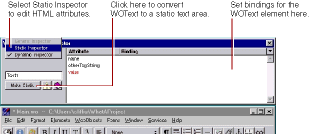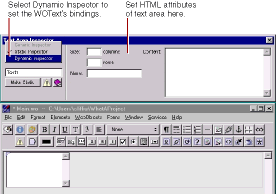Dynamic and Static Inspectors
Most dynamic elements have static HTML counterparts (with the exception of abstract dynamic elements, such as: WOString, WORepetition, WOConditional, and WOCustom.) The Inspector for these elements has two states:
- The Dynamic Inspector, which you use to set the bindings for the element (see Binding Elements ).
-
The Static Inspector, which you use to set the HTML attributes for the element's static counterpart.


To switch back to the WOText Inspector, select Dynamic Inspector from the pop-up list.
In addition, you can convert any dynamic element into its static counterpart, or vice versa:
- When inspecting a dynamic element, if you click Make Static, the element becomes its static counterpart (if it has one), and the Static Inspector appears.
- When inspecting a static element, if you click Make Dynamic, the element becomes its dynamic counterpart. Both the Static and Dynamic Inspectors are now available.
Static Element |
Dynamic Counterpart |
|---|---|
If you convert a static element to its dynamic counterpart by clicking Make Dynamic, and there is no direct counterpart, the element becomes a generic WebObject whose element name is the HTML tag for the static element (see Generic WebObjects ).
© 1999 Apple Computer, Inc. – (Last Updated July 27 99)